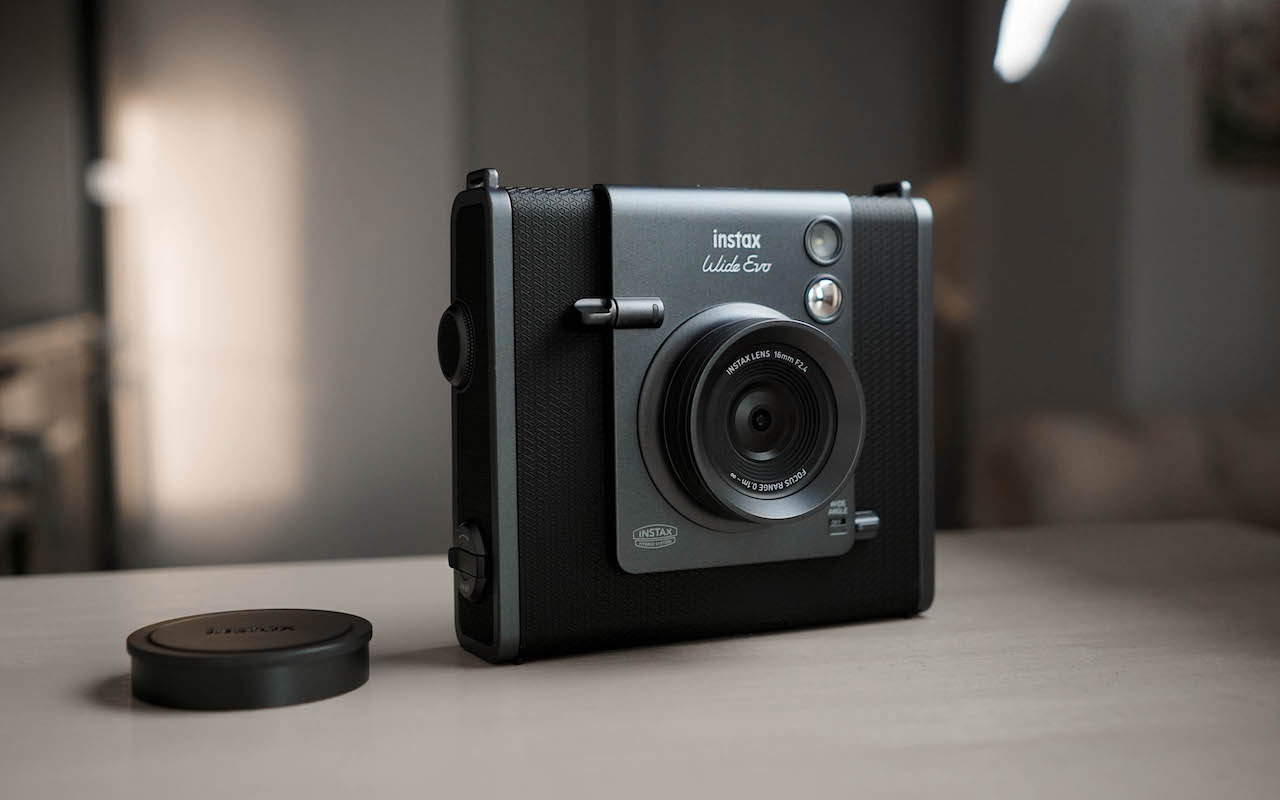
A picture is worth a thousand words—so how many words is it worth if your instant camera can customize your picture 120,000 different ways? The Fujifilm Instax WIDE Evo hybrid instant camera is a unique camera that captures and customizes digitally but prints in analog to produce gorgeous, dreamy photographs with every shot.
What’s in the box of the Fujifilm Instax WIDE Evo?
In the box of the Fujifilm WIDE Evo, you’ll find the camera body with a detachable lens cap, a USB-C cable, a three-piece shoulder strap, and a quick start guide. As this Instax model recharges via USB-C, there are no batteries in the box.
Technical specs of the Instax WIDE Evo
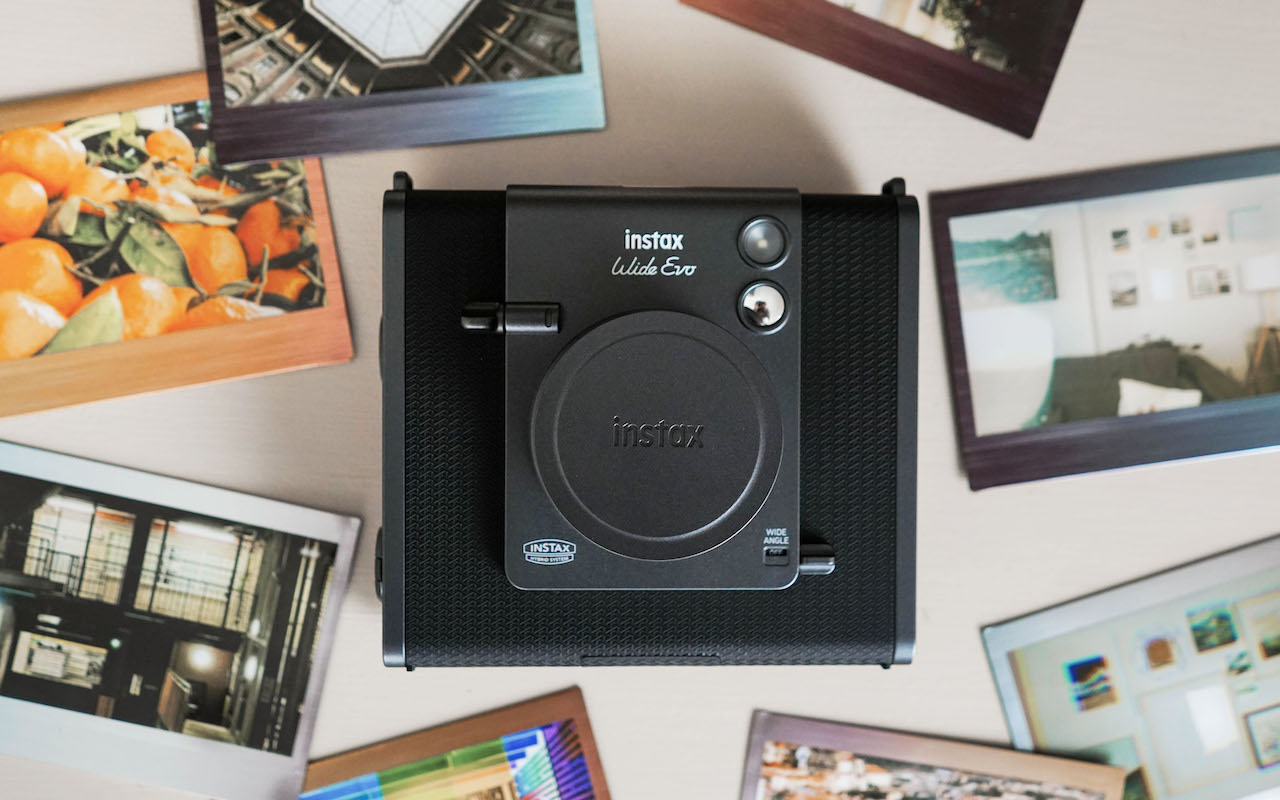
The Instax WIDE Evo is currently the most advanced Fujifilm Instax camera—and it has the specs to back up that claim. This hybrid instant camera offers more combinations of film, lens, and border effects than ever before. On top of that, it offers the same fine-tuning that you’d expect out of a digital camera: Functions such as white balance, exposure compensation, face recognition, and more.
Camera functions
- Lens effects: 10
- Film effects: 10
- Border effects: 6
- Exposure: -2 to +2 exposure compensation
- White balance: Yes (7 modes)
- In-body flash: Yes
- Auto power off: Yes
- Autofocus: Yes, with optional face recognition
- Self-timer: Yes (2 seconds, 10 seconds; remote trigger using Instax WIDE app also available)
- Memory: ~45 images without micro SD added (~280 WIDE images or 850 normal images per gigabyte)
Camera body
- Battery: Lithium ion
- Size: 6.27 cm x 13.87 cm x 12.5 cm
- Screen size: 3.5″
- Weight: 490 g
- Sensor: 1/3″ CMOS sensory with primary colour filter
- Aperture: f2.4
- ISO sensitivity: ISO100-1600 (automatic only)
- Normal mode images: 2560 x 1920 pixels captured at a sensor-cropped focal length of 28 mm (35 mm equivalent)
- Wide angle images: 4608 x 3456 pixels captured at a focal length of 16 mm
- Bluetooth: 5.1
Layering effects for unique photographs
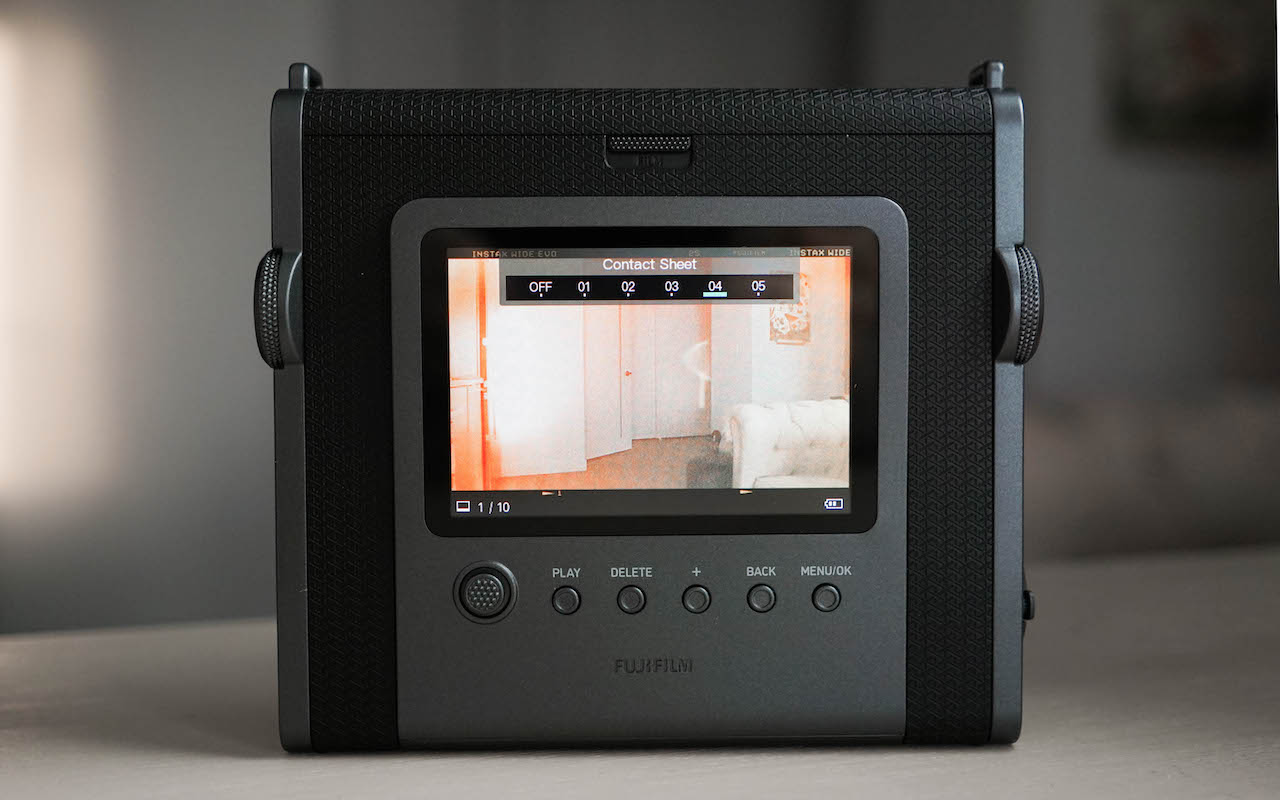
What makes the Instax WIDE Evo so unique is its immense ability to customize every shot. It features 10 lens effects, 10 film effects, and 6 border effects, each of which can be layered with the others. This isn’t a simple combination of 10 by 10 by 6, however: Within each lens effect, the WIDE Evo includes micro-adjustments.
The mode dials on the back left and right of this camera control the camera’s lens and film effects. As you flick through lens effects, you can fine-tune each of them using the lens ring on the front of the camera. In this instant camera, what would normally be the focusing ring of your camera lens functions instead as a lens effect intensity ring. By turning the ring, you control the intensity of your lens effect.
The intensity sits on a scale of 1-100 for each. For whole-image effects like Vignette and Soft Glow, turning the ring makes the effect more or less intense. However, for gradient effects like Beam Flare and Colour Gradient, turning the ring rotates the gradient. For stamped-on effects like Light Leak, turning the ring offers 100 different light leak overlays.
Effects to layer
| The Instax WIDE Evo’s lens effects include: | The Instax WIDE Evo’s film effects include: | The Instax WIDE Evo’s film style borders include: |
| Normal Light Leak Stretch Glass Vignette Soft Glow Double Exposure Colour Shift Monochrome Blur Colour Gradient Beam Flare | Normal Vivid Warm Light Blue Pale Green Magenta Sepia Monochrome Retro Summer | Normal Cinematic Perforated Date Stamp Contact Sheet Collodion Process |
Why does intensity matter?
The film and lens effects of this camera are what make it really special. So, having such an incredible ability to fine-tune each lens effect makes a big difference.
Take the Light Leak effect, for instance. Light leaks are so bright, vibrant, and joyful. They’re a wonderful way to add life to a photograph, but what makes them special in film photography is that they’re unique. Two physical light leaks could be similar, but they’d never be identical. Seeing two prints with identical light leaks in them creates a synthetic, mass-produced effect, which is the opposite of what instant photography usually achieves.
With 100 different light leaks in play in the Instax WIDE Evo, Fujifilm recreates that feeling of newness—of uniqueness; of spur-of-the-moment creation. You get to give the dial a wild spin with each photograph, then capture the completely random light effect that it gives you. Or, to curate the perfect shot, you can slowly rotate through each effect intensity to get it just right every time.
The same applies for the WIDE Evo’s other lens effects. Each one can be tweaked and combined just so. A traditional film photo comes out a little different every time, so why shouldn’t your instant photos?
Thoughtful details for thoughtful captures
Fujifilm did a great job of making their effects feel really thoughtful, and thankfully, the same can be said about their product design in the WIDE Evo. You can really feel the intentionality in its design, from the camera’s satisfying mechanical dials to its perfectly-fitted, felt-lined lens cap.
One of my favourite thoughtful details about this camera is its camera strap. This is a strap design that Fujifilm updated recently (I first saw it in 2024), and it’s a joy to use. Instead of having to loop, adjust, and secure the entire strap every time you want to put it on or take it off, Fujifilm has designed the strap with a three-part mechanism. The strap comes on and off of two tiny (but very secure) clips, making it the easiest-to-use camera strap I’ve ever worked with.
Charging this instant camera is also easy, with a USB-C plug that you likely already have in your camera bag. It’s lightweight and gorgeous, with a mix of finishes that feel satisfying in your hand. Another detail that I think is going to be a big hit is the camera’s “print” function. It’s not intuitive to use the first time around, but once you’ve used it once, you’ll never forget it.
To take a photo, you gently press the toggle on the front of the Instax WIDE Evo camera—which takes a photo, but doesn’t print it. To print, you flip out the film crank on the right hand side of the camera body. Turning the crank “pushes” the print out of the top of the camera, complete with a digital animation. I’ve had a few friends borrow this camera already (I took it out for the night on Valentine’s Day) and every one of them commented on the crank independently. It’s so unique, memorable, and fun to use!
How does the Instax WIDE Evo compare to the Instax Mini 99 and Instax Wide 400?
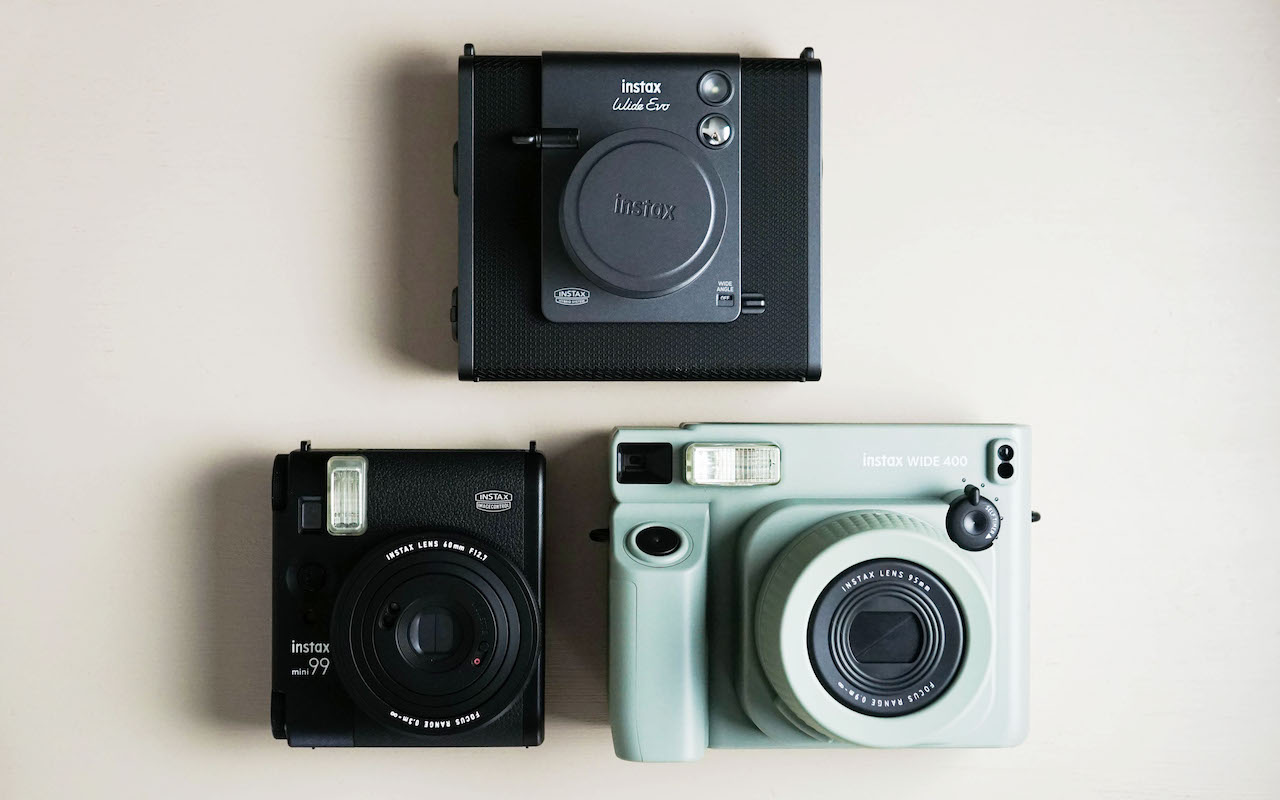
The Instax WIDE Evo is an incredibly unique product, but Fujifilm has two other cameras in its lineup that are somewhat similar to it. First, there’s the Fujifilm Instax Mini 99, which features similar lens and film effects to the WIDE Evo. Then, there’s the Fujifilm Instax Wide 400, which also prints on Fujifilm’s wide-format instant film.
Of these three cameras, I prefer the WIDE Evo by a long shot—and I’ll tell you why.
The Instax Mini 99 is a wonderful camera (I reviewed it here) that’s a pleasure to shoot with. I love its size, design, and customizability. It’s a very tactile, compact camera that’s thoughtfully and intuitively designed. If you want to shoot with Mini film, I think it’s the best possible camera you could buy right now. However, each Mini 99 photo can be customized to create just 300 different images. When you factor in the intensity dial and wide angle toggle of the WIDE Evo, each of its shots can be customized to have created 120,000 different images.
I generally prefer a wide format print when it comes to instant photography, so I also really enjoyed using the Instax Wide 400 (reviewed here). Despite using the same film, however, the Wide 400 and WIDE Evo could not feel more different! The Wide 400 is a simple shooter with no effects, no rechargeable battery, and a basic, playful design. It’s a great camera, but fills a totally different niche than the WIDE Evo.
My experience with the Fujifilm Instax WIDE Evo
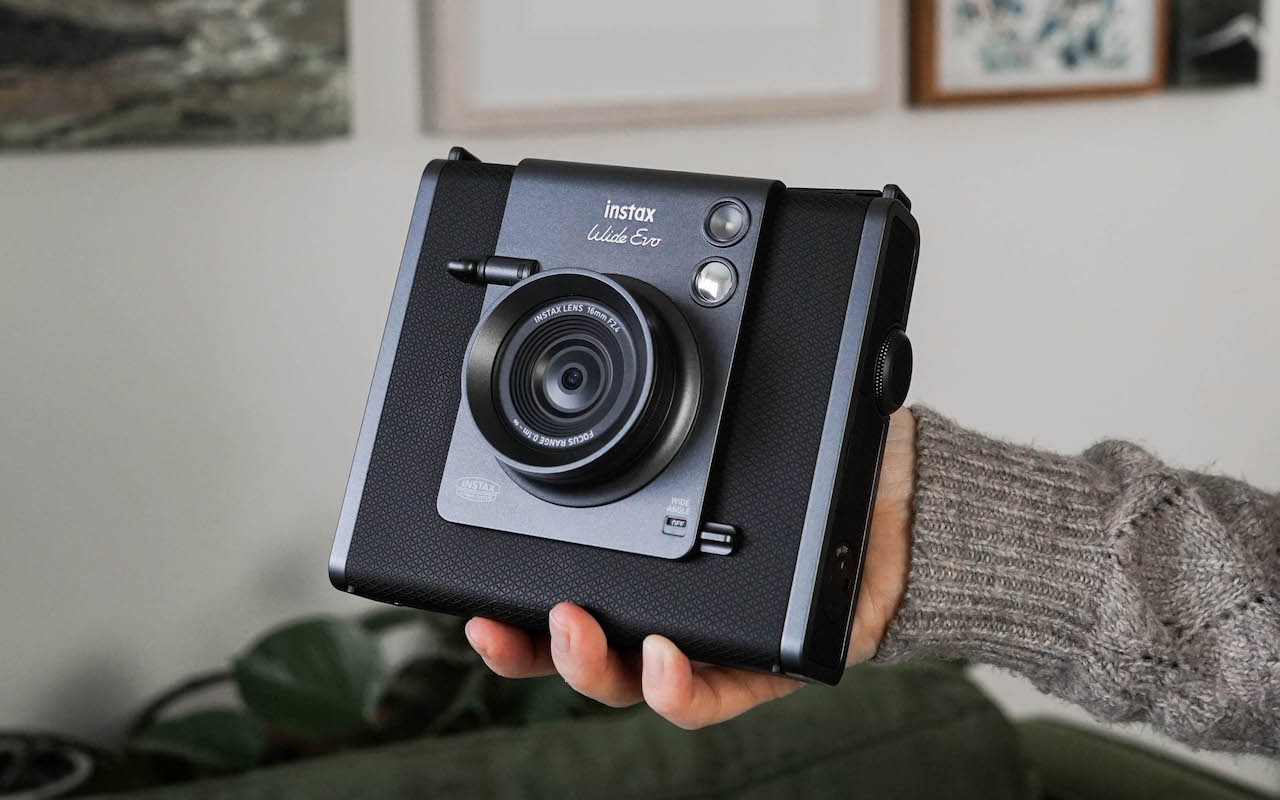
I loved using the Fujifilm Instax WIDE Evo hybrid instant camera. It’s a well-designed, thoughtful piece of technology that I think will appeal to a very different audience than the Fujifilm Instax Mini line. I love the Minis, but they’re designed to be simple and silly—the WIDE Evo is certainly not that.
With its wide-format film and overwhelming customizability, the WIDE Evo is an interesting, heavily artistic product. It’s not a seamless camera to pick up and use for the first time (there are just so many settings), but once you’ve captured a couple of shots, you’ll get the hang of it. I like that it’s designed for heavy app integration, with in-app features that let you print from your phone, remotely trigger the shutter, and explore other user’s photos and presets.
One thing to note is that the WIDE Evo can print from the app, but your options for post-capture customization are limited. You can modify things like the print’s exposure and tilt, but you won’t be able to add or change a lens effect, film effect, or film style border. Those are the features that really make the WIDE Evo special, so it’s worth noting that they’re kept as an in-the-moment option. Personally, I would prefer to have the ability to add these effects after the fact because it makes it so much easier to stay in the moment, but I think this was an intentional decision on Fujifilm’s part. The permanence of your effects makes the initial capture more difficult to get just right, but it keeps things feeling special and a bit reverent—which any photographer knows is very, very characteristic of film photography.
Final thoughts on the Instax WIDE Evo
If you’re a film and photography enthusiast who wants to get into instant photography, there’s no better camera to start with than the Fujifilm Instax WIDE Evo hybrid instant camera available now at Best Buy Canada. It’s a great, thoughtfully-designed instant camera and printer that creates lasting, memorable images. Make sure to stock up on film at the same time (you can grab a two-pack of film here) as the WIDE Evo will have you wanting to print every photo!





